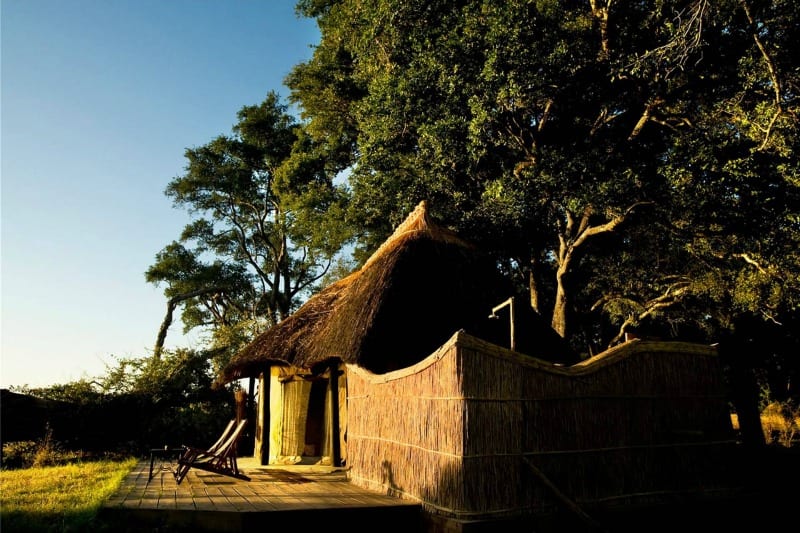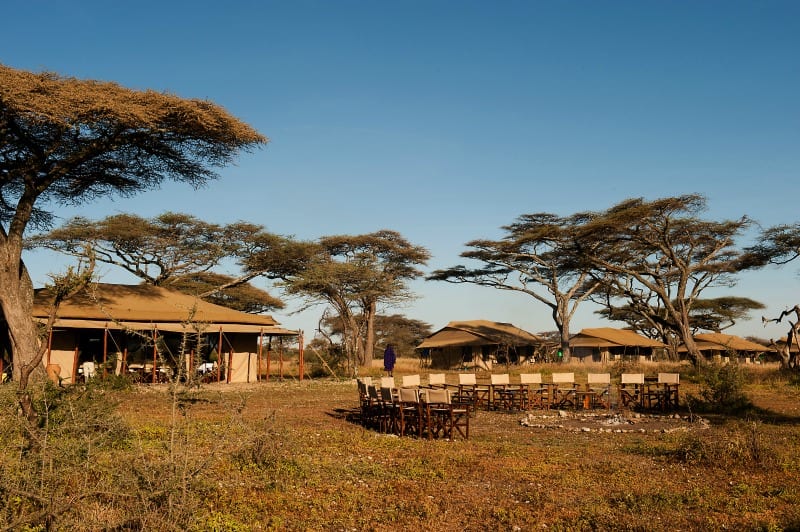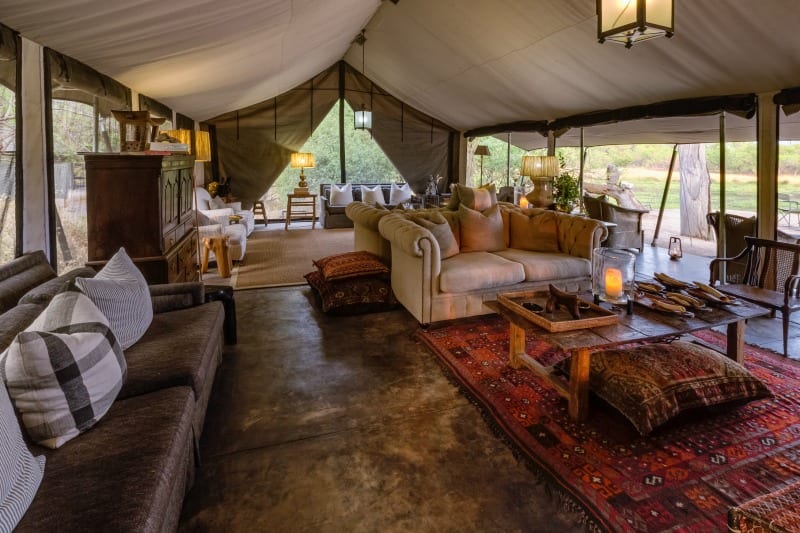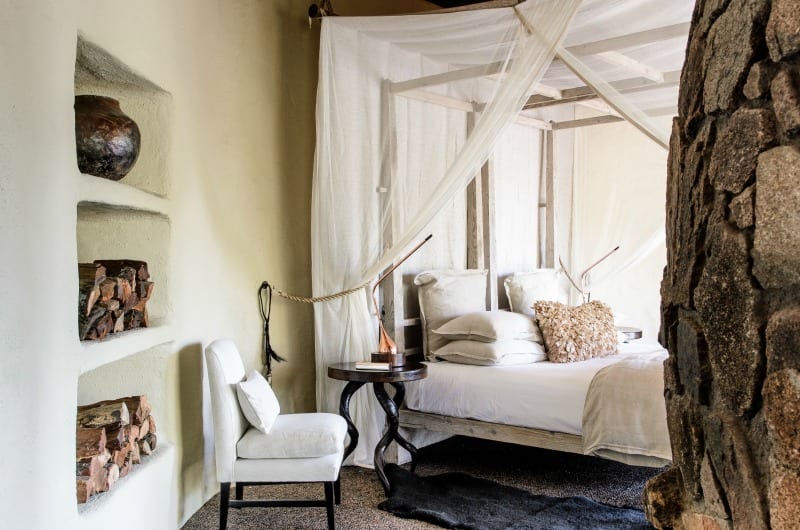Rothschild Safaris does not own any accommodation or Safari camps in Africa.
This is a very good thing because it allows us complete flexibility and more importantly, variety for your individual taste.
Each year, our travel designers go on their own African safaris. They visit the camps to personally experience the accommodations, activities, the best seasons for game viewing, meals, and service.
Our recommendations for you are based on expert and first-hand experience.
Following is a guide to help understand the different accommodations and clarify your travel style:
Bush Camp
African safari bush camps are simple, seasonal camps that are ingeniously designed. They are in stunning remote locations, worth visiting simply for the once-in-a-lifetime experience they offer. It is often possible to take a guided walk or go for night drives from bush camps. They do not pretend to be ultra-luxurious, although they cater to most peoples’ needs.
Bush camps are usually re-built at the beginning of each dry season using local materials (reeds, grasses, poles, and thatch). The rooms are often adorned with local artifacts. Most have en-suite flush loos and overhead showers, although some have more simple arrangements.
More rustic satellite African safari bush camps are simpler and smaller, normally with just three or four rooms in total. The dining areas frequently have both a thatched roof section and a second more open area, perhaps under the shade of a huge Tamarind tree. Dinners are often enjoyed under the stars, candlelit, and accompanied by the evening calls of the wilds.
Since one of the greatest things about an African safari is the sensation of being in wild remote places, these simpler camps often become the most memorable part of the adventure.

Mobile Tented Camp (also known as Under Canvas Camps)
When you hear, “Experience Africa under Canvas,” one might be quick to think, “Camping.” This is true, although we must be clear. This is not “camping” as most people might imagine it.
Mobile Tented Camps on an African safari are typically in remote locations with high wildlife densities. Your “walk-in” tent is often just like a hotel room but with canvas walls. Tents are equipped with a bed, linen, bedside light, room for your clothes and belongings to spread out. There are large netted windows on all sides, with rain flaps that can be zipped up easily. There is an en-suite bathroom area at the rear of the tent with an eco flush toilet and safari-style bucket shower. Jugs of hot and cold water are delivered to your tent when you’d like them.
The main dining tent sits in the middle of the line of tents with a fireplace right in front and a separate library/bar tent nearby. An excellent example of a mobile camp is the Serengeti Safari Camp which follows The Great Migration.
Not so long ago, all luxury African safaris accommodated their clients in mobile camps, simply because these provided the best accommodation in the bush, by far. It also meant you could move with your home. Famous personalities have traveled on African safaris and stayed in a mobile tented camp, including Teddy Roosevelt and Prince Charles.
The mobile tented camp can be booked solely on an exclusive basis. Should you book this solely, there would be no need for you to accommodate other people here, no waiting for service while the steward attends to other guests, or having to explain which group you belong to, so you may be told where your dining table is located. There are no set meal times. In many ways, the camp becomes your home on your African safari. You have meals when you want, and how you want.
You also have the benefit of camp facilities while on your activities. One day your guide might plan an early start and take a picnic breakfast in the vehicles. You can then stop at your convenience, find a spot and sit in camp chairs or on a rug adorned with cushions, and watch, for example, zebras come to a waterhole to drink. Another day the camp crew might bring out an elaborate brunch that you can enjoy sitting at a dining table set under an acacia tree and served by the camp waiters. Each day is different and because you do not need to concern yourself with other guests and the crew does not have to cater for anyone else, you are at liberty to relax and experience the rhythm of Africa in a way that is hard to do in larger camps or lodges.
Mobile tented camps are ideal when sited in quiet areas with minimum development, or in areas well worth experiencing because of high wildlife densities perhaps, and where other accommodation is basic or there are no other facilities.
While these camps can be moved, it is quite an operation, and so today they are generally set up in one special spot for the season (like the non-exclusive seasonal tented camps, for one to three months). Depending on the time of year the camp might either be in the best place for the migrant wildlife at that time of the year (especially relevant in the Serengeti, where a large numbers of the wildlife are on the move) or in an area with a lot of freedom (such as being outside a national park).
Mobile tented camps are especially suited for groups of more than five people, as these camps are the best way to experience the African wilderness without disturbing other tourists, while enjoying every luxury you could want, and especially when you are accompanied by close family or friends.
Experiencing Africa under Canvas is by far one of the most exhilarating ways to go on safari. There is something romantic, yet raw about the mobile-tented camp. It may be passing dimly lit lanterns as you adjourn to your tent or the natural sound system of the bush’s nightly calls. After spending the night under canvas, with the bush in your backyard, dreaming of the wildlife you have just seen, you will realize how fully connected you and the wilderness have become.
It is a magical bond that is difficult to create so quickly under other circumstances and it is only one of the many additional benefits to choosing an African safari under canvas.

Naturally, as times change, safaris, camps, and areas of pristine bush will continue to change.
Changes have affected a move from mobile camps to other types of accommodation when on Safari:
Permanent Tented Camp
Permanent tented camps on African safaris vary widely in size, standard and the experience they offer, and often are located inside national parks and in more remote areas than lodges. They can be similar to lodges, but permanent camps nearly always have some tentage used in the structure, and often imbibe a more “outdoor” feel, with a campfire near the lounge, and subdued lighting.
Most permanent camps that we recommend on our African safaris are luxurious. They rarely have more than 15 tents (usually no more than eight), and even when that large, will normally have more than one dining room, providing a more intimate atmosphere within your group. All have modern plumbing, shower and toilet facilities with running water, some have a swimming pool, and occasionally (not always) a communication center and perhaps a small gym.
Most permanent tents are not exclusive, meaning you are likely to meet other groups during your stay. However, as previously stated, there are generally fewer rooms, of higher quality, available at permanent camps. The quality of each suite, alongside the calm and remote location, make permanent camps a great destination for your honeymoon or romantic getaway.

Safari Lodge
In the last decade, African Safaris have become endowed with increasingly more truly luxurious lodges.These epitomize the word “luxury” and cater to every imaginable wish. The standards encountered in the classiest of these match those of the finest hotels in the world. For this reason, they are the accommodation of choice for groups where luxury and comfort is the prime consideration. These are rarely situated in as wild and remote areas as the mobile camps, but they are often placed in strategic locations with amazing panoramas and offer superb views.
Lodges in Africa take pride in their ability to incorporate their establishments within the environment. They combine elements of African architectures with absolute style. These luxury facilities blend themselves into the landscape so as to not jeopardize the surrounding ecosystem. Similar to that of an American resort, their structure is built with connecting hallways, a dining area, and additional guest suites. Because lodges typically have more rooms, you will find greater numbers of people, often times with children. Meals are generally served buffet style for breakfast, lunch, and dinner.
Lodges generally are built of locally sourced rock and stone, or in some highland areas, of timber. They usually, though not always, accommodate more guests than camps. We might recommend a lodge over a camp on your African safari in colder areas as the rooms are warmer, and may have heating, hot tubs, and other facilities. When you are staying on a farm or in a town, you are more likely to stay in a lodge than a camp. As expected you will find modern plumbing, shower and toilet facilities and running water. Often (although not always) lodges have a communication center. Many have a swimming pool and spa and massage facilities, and a few even have a small gym.

